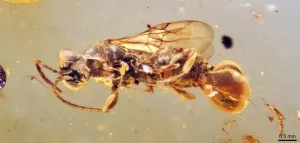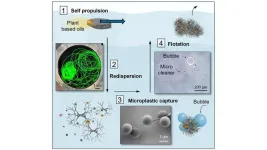(Press-News.org) An extinct lineage of parasitic wasps dating from the mid-Cretaceous period and preserved in amber may have used their Venus flytrap-like abdomen to capture and immobilise their prey. Research, published in BMC Biology, finds that the specimens of Sirenobethylus charybdis — named for the sea monster in Greek mythology which swallowed and disgorged water three times a day — date from almost 99 million years ago and may represent a new family of insects.
The morphology of S. charybdis indicates the wasps were parasitoids — insects whose larvae live as parasites and eventually kill their hosts. Modern-day parasitoids of the superfamily Chrysidoidea include cuckoo wasps and bethylid wasps. However, the S. charybdis specimens possess a unique pattern of veins in the hind wing that suggests the species belongs within its own family, the Sirenobethylidae.
Taiping Gao, Lars Vilhelmsen, and colleagues from the Capital Normal University, China, and the Natural History Museum of Denmark used Micro-CT scanning to analyse 16 female S. charybdis specimens preserved in amber dated to 98.79 million years ago. These specimens were collected from the Kachin region in northern Myanmar. They find the species was likely to have been a koinobiont — a parasitoid which allows its host to continue growing while feeding on it. The wasp specimens have an abdominal apparatus comprised of three flaps, the lower of which forms a paddle-shaped structure with a dozen hair-like bristles, visually reminiscent of a Venus flytrap plant. The authors note the abdominal apparatus of S. charybdis is unlike that of any known insect, and may have served as a mechanism to temporarily restrain the host during egg-laying. As the wasp was likely unable to pursue prey over long distances, they speculate that it would have waited with the apparatus open for a potential host to activate its capture response.
The authors believe the elaborate grasping apparatus allowed S. charybdis to target highly mobile prey such as small, winged or jumping insects. The preserved specimens suggest that Chrysidoidea displayed a wider range of parasitoid strategies in the mid-Cretaceous period than their present-day counterparts.
END
Fossils: Ancient parasitic ‘Venus flytrap’ wasp preserved in amber
2025-03-27
ELSE PRESS RELEASES FROM THIS DATE:
New species revealed after 25 years of study on ‘inside out’ fossil – and named after discoverer’s mum
2025-03-27
A new species of fossil from 444 million years ago that has perfectly preserved insides has been affectionately named ‘Sue’ after its discoverer’s mum.
The result of 25 years of work by a University of Leicester palaeontologist and published in the journal Palaeontology, the study details a new species of multisegmented fossil and is now officially named as Keurbos susanae.
Lead author Professor Sarah Gabbott from the School of Geography, Geology and the Environment said: “‘Sue’ is an inside-out, legless, headless wonder. Remarkably her insides are a mineralised ...
THE LANCET HIV: Proposed cuts to foreign aid could result in millions of HIV deaths and soaring rates of global HIV infections, new modelling study estimates
2025-03-27
New modelling analysis suggests that proposed funding cuts by major donor countries to foreign aid could undo decades of progress made to end HIV/AIDS as a public health threat and new infections and deaths could surge back to levels not seen since the early 2000s.
The study estimates there could be between 4.4 million to 10.8 million additional new HIV infections by 2030 in low-and-middle income countries (LMICs) and between 770,000 to 2.9 million HIV-related deaths in children and adults by 2030.
The greatest impact from potential funding ...
Study reveals association between dietary sodium consumption and both general and abdominal obesity
2025-03-26
New research to be presented at this year’s European Congress on Obesity (ECO 2025, Malaga, Spain, 11-14 May) shows an association between the amount of sodium consumed in the diet and the risk of both general and abdominal obesity. The study is by Annika Santalahti, Finnish Institute for Health and Welfare, Helsinki, Finland, and colleagues.
General obesity is a person’s obesity status as measured by their body mass index (BMI), with WHO international guidelines stating a BMI of 30 kg/m2 or more means a person is living with obesity. Abdominal obesity is where fat accumulates around the abdomen and internal organs there, leading ...
Study finds knowledge of genetics and genomic medicine crucial for mental health providers to deliver informed, personalized care
2025-03-26
San Diego—March 26, 2025– In a manuscript published today in the American Journal of Psychiatry titled Psychiatric Genetics in Clinical Practice: Essential Knowledge for Mental Health Professionals, authors provide updated guidelines on what mental health professionals should know about the latest advances in genetics and how genetics can inform clinical psychiatric practice.
Key findings highlight the importance of understanding the genetic architecture of psychiatric disorders, the potential applications of genetic information in risk assessment, diagnosis, treatment selection, and patient education, ...
Hypersonic simulation in 3D exposes new disturbances
2025-03-26
At hypersonic speeds, complexities occur when the gases interact with the surface of the vehicle such as boundary layers and shock waves. Researchers in the Department of Aerospace Engineering in The Grainger College of Engineering, University of Illinois Urbana-Champaign were able to observe new disturbances in simulations conducted for the first time in 3D.
Fully 3D simulations require a great deal of processing power, making the work expensive to compute. Two things made it possible for Deborah Levin and her Ph.D. student Irmak Taylan Karpuzcu to conduct the research: Time on Frontera, the National Science Foundation-funded leadership-class computer system at the Texas ...
Your neighborhood may affect your risk of dementia
2025-03-26
EMBARGOED FOR RELEASE UNTIL 4:00 P.M. ET, WEDNESDAY, MARCH 26, 2025
MINNEAPOLIS — People living in more disadvantaged neighborhoods may be more likely to develop dementia than people living in neighborhoods with fewer disadvantages, according to a study published on March 26, 2025, online in Neurology®, the medical journal of the American Academy of Neurology. The study does not prove that neighborhood factors cause dementia; it only shows an association.
Neighborhood status was determined by factors such as income, employment, education and disability.
“Our findings show that the community in which you live influences your risk of developing dementia,” ...
Early signs of heart problems linked to smaller brain volumes
2025-03-26
EMBARGOED FOR RELEASE UNTIL 4:00 P.M. ET, WEDNESDAY, MARCH 26, 2025
MINNEAPOLIS — People who have early signs of heart problems may also have changes in brain health that can be early signs of dementia, such as loss of brain volume, according to a meta-analysis published on March 26, 2025, online in Neurology®, the medical journal of the American Academy of Neurology. The meta-analysis does not prove that early heart problems cause loss of brain cells; it only shows an association.
“This review shows that better ...
Research finds potential “molecular mimics” behind COVID-induced autoimmune disease
2025-03-26
COVID infection has been linked to higher risk of autoimmune disorders, including rheumatoid arthritis and type 1 diabetes. But why the virus might cause the body’s immune system to go haywire remains unknown, making it difficult to develop therapies to avoid autoimmunity. One hypothesis is that viral “molecular mimics” that resemble the body’s own proteins trigger an immune response against the virus—and healthy tissues get caught in the crossfire.
Now, with advanced data analysis and machine learning, scientists have identified a set of COVID-derived ...
Pennington Biomedical researchers identify neurons in brain that regulate energy levels and body temperature
2025-03-26
FOR IMMEDIATE RELEASE
March 26, 2025
BATON ROUGE – Scientists at Pennington Biomedical Research Center have gained greater clarity in the brain regions and neurons that control metabolism, body temperature and energy use. Featured in the February edition of the journal Metabolism, Dr. Heike Münzberg-Gruening and a team of researchers discovered which chemicals influence the signals that control how much energy the body uses. In “Leptin Receptor Neurons in the dorsomedial hypothalamus require distinct neuronal subsets for thermogenesis and weight loss,” researchers laid out the pathways, chemicals, neurons ...
Cleaning microplastics
2025-03-26
In a new paper, researchers at North Carolina State University show proof of concept for a system that, in a single cycle, actively removes microplastics from water.
The findings, described in the journal Advanced Functional Materials, hold the potential for advances in cleansing oceans and other bodies of water of tiny plastics that may harm human health and the environment.
“The idea behind this work is: Can we make the cleaning materials in the form of soft particles that self-disperse in water, capture microplastics as they sink, and then return to the surface with the captured microplastic contaminants?” said Orlin Velev, the S. Frank and Doris Culberson Distinguished ...





